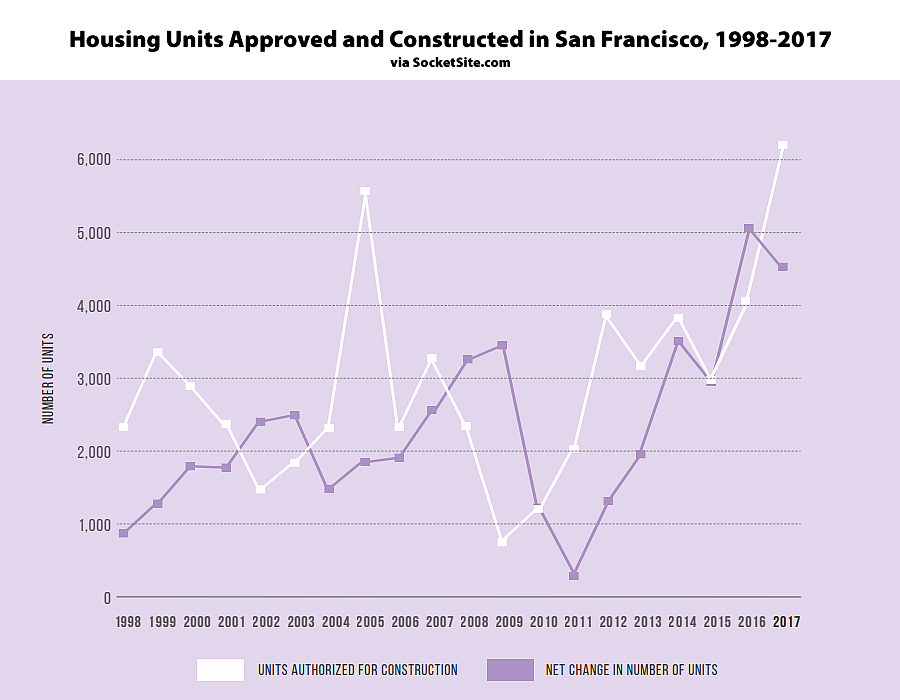Including finished new construction projects and conversions, 4,441 net-new units of housing were added to San Francisco’s stock of housing last year, down 12 percent from 5,046 in 2016 but nearly double the 20-year average of 2,295, figures which are slated to be presented to San Francisco’s Planning Commission next week.
As such, San Francisco’s overall housing stock now totals just over 392,000 units, including 124,000 single-family homes and 111,500 units in multi-family buildings with 20 units or more.
At the same time, plans for roughly 6,700 units of new housing were authorized by the City over the past year, a 66 percent increase from 4,100 in 2016 and versus a 20-year average of 2,940, leading to San Francisco’s record housing pipeline, but downward trend in actual building, as we first reported last month.


4000 or 5000 a year is pretty respectable, but not historically unprecedented. In the 1940s San Francisco produced 5000/year sustained for the whole decade, and in the 1950s it was 3700/year on average, with mid-20th-century technology and a falling population.
You’re exactly right.
Perhaps that has something to due with land availability: weren’t there still large stretches of virgin land west of Twin Peaks up until about 1950?
The original buildings across the entire city were built prior to 1950, so yes. But the pace of net new housing was still very high in the 1950s as buildings were replaced by larger buildings.
Great for housing providers. Roll back or modify Costa Hawkins and watch the deliveries plummet. Consistent with softening prices for lightly used condos.
When approved plans constitute a tiny fraction of the cost of a project, that money is easy to spend compared to actual construction dollars.
More sideways market pricing and tight supply.
Good point. To be on the safe side developers might want to map their apartment projects as condos if those projects are set for approval prior to the vote. There is a huge push for the initiative and early polls in SOCAL have fifty-nine percent of voters supporting such a measure in the Southern California counties of Riverside, San Bernardino, Ventura and Santa Barbara. That sounds quite a bit high to me and it depends on how the poll questions are worded. Still, this is going to be closer than many are assuming. If it passes it is a game changer for residential development in SF – deliverables could indeed plunge.
Sounds like some totally bogus pro tenant group poll. I doubt this will pass. Home and condo owners will not be for this, as it limits their personal property use. And they are the majority in the state. They’ll be so much “No” campaigns mounted by the real estate association and developers, it’ll drown out the tenant groups imo.
As I noted, I found the poll’s numbers suspect. That said, it is not going to be a cake walk and especially if there is a huge anti-Trump progressive turnout. The initiative supporters have deep pockets and will be able to mount a strong advertising effort which is usually not the case. If it were to pass then for sure SF would impose across the board rent control and possibly vacancy control. All the developer money behind these proposed residential projects will depart overnight – to Seattle and other markets. It’s all about ROI which, as it is, is not that great for new investors in SF.
Does anyone know when the Q1 2018 SF housing pipeline becomes available?
The Q1 data is typically released in April or May. We published the most recent pipeline data last month.
San Francisco could absorb 50,000 more units of housing or more. Still, not bad.
What a crazy graph. It’s like a roller coaster.